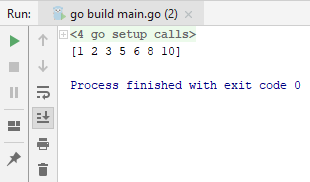In this section, we are going to learn how to reverse sort an array. We'll have a variable that holds a slice of numbers. Since you are now familiar with the sort package in Go, you'll know that the sort package provides a lot of functionality that we can use to sort arrays and slices. If you look at the sort package, you'll see many types and functions.
Now, we need the sort function and it accepts an interface, and this interface is defined in the sort package; therefore, we can call it the Sort interface. We are going to convert our slice of numbers into an interface. Check out the following code:
package main
import (
"sort"
"fmt"
)
func main() {
numbers := []int{1, 5, 3, 6, 2, 10, 8}
tobeSorted := sort.IntSlice(numbers)
sort.Sort(tobeSorted)
fmt.Println(tobeSorted)
}This code will give you the following output:

If you look at the output, you'll see that we have sorted the numbers in ascending order. What if we want to sort them in descending order? To be...



